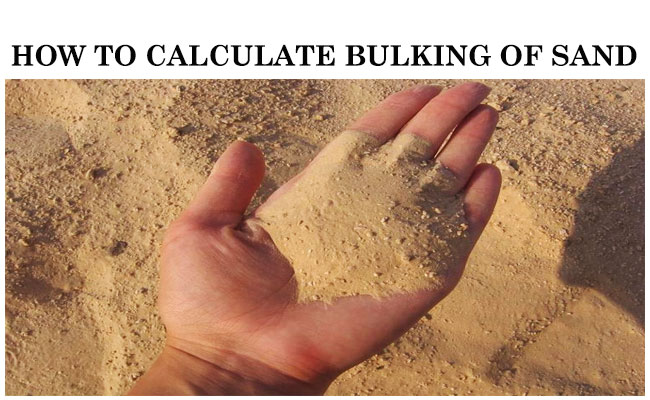How to Calculate Bulking of Sand

When dry sand gets in touch with moisture contents, a thin film is developed near the sand particles. As a result they are detached from one another. This situation leads to expand the volume of sand. This enlargement is defined as sand bulking.
Bulking of sand is completely based on the moisture contents. Bulking is raised with the increment of moisture contents. It is known that 4% moisture contents (by weight) of dry sand will raise its volume up to 25 to 30% on the basis of the grading.
Greater amount of finer sand particles contribute to higher bulking. Besides, inclusion of water leads to rupture of the film near the sand particles and consequently, the volume of sand is significantly decreased.
As for example, if the water quantity in sand remains in excess of 20% or the sand is completely submerged in water, its volume becomes equivalent similar to dry sand.
Because of bulking of sand, at the time of choosing nominal mix (by volume mixing) of concrete, normally, the calculation is done 1.52 cum with the purpose of acquiring 1 cum of material.
Implications of sand bulking
While accomplishing concrete batching, extra sand is added to raise the volume of sand. Because of the moisture in surface, the honeycomb may be developed in concrete. It will significantly impact the volumetric mix ratio of concrete and the strength of concrete will be decreased.
The concrete is likely to be stony and it is susceptible to the segregation. Extra moisture contents in the sand can reduce the stability of concrete and reduce the strength of concrete.
It should be kept in mind that extra growth of workability can raise the setting time of concrete but the strength of concrete is reduced.
The volume alias bulking is raised since sand consumes moisture.
In construction work, the content of moisture should remain below 5%.
If the moisture content remains about 6 to 10%, there is possibility for breaking of the film and consequently the volume is decreased. When sand consumes moisture again, no bulking occurs.
When the moisture content remains 5 to 10%, the volume of concrete will be raised approximately 20 to 40%.
The calculation of bulking can be performed with a simple field method as per IS 2386 code. Under this method, the behavior of sand grains is examined against different proportions of moisture contents.
To conduct the test, different types of instruments like 250 ml measuring cylinder, container, steel rule, steel rod with 6 mm dia, sample sand etc. will be required. The steps are as follow:-
Initially, select a measuring cylinder with 250 ml capacity.
Put the sample of damp sand in the cylinder.
Fill up the sand up to 200 ml and shiver properly, then note down the level as a.
Provide 100 ml water to cylinder to fully soak the sand and shake properly.
Once shaking is finished, the level of sand will be reduced under the 200 ml mark. Note down this level as b.
Reiterate the similar method for 2 more samples.
Now, work out the proportion of bulking of sand with the following formula:-
% of bulking of sand = {(200-b) / b} x 100
In this way, the original volume of related dry sand will be determined (that is raised due to the volume of bulkiness) by deducting it from the calculated volume of sand.

